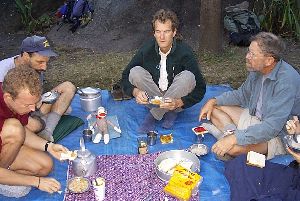
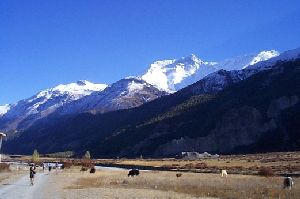

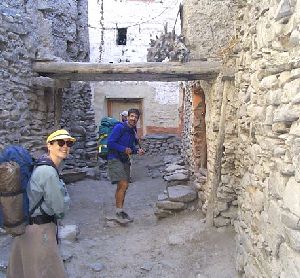
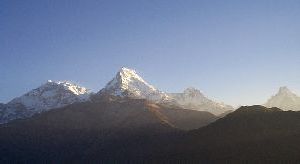
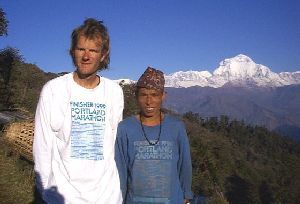
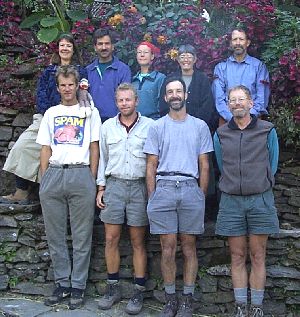
|
A Day in the Life
A typical day began at 6:300am by waking up to the cry of "Tea, Coffee!" by the youngest assistant cook. You lurched upright in your sleeping bag and put your hand outside the tent door. A mug of hot tea would magically appear as you mumble, "Ek chinni", meaning "One sugar". About the time the tea is hitting bottom, you hear the same squeaky voice yell, "Hot water!" This is your cue to roust out of the tent with your bags packed and wash in the basin of hot water provided to each person just outside the tent.
OK, now you are mostly awake, so you amble over to the blue tarp. (Yes, a blue plastic tarp just like you would buy at Fred Meyer.) Breakfast is rice porridge, or oatmeal, or corn flakes, usually with toast. And the ubiquitous tea. (Staying hydrated tends to be a problem during a trek.)
Breakfast comes to an end when Patam (one of the guides) shoulders his pack and shouts "Johnnie Ho!". What he is actually saying is a corruption of janné ho, which translates roughly as "Let's go!".
So you pull on your day pack and start walking. It turns out that even though you are often walking at high elevations, the day's walk is usually not that hard. After 3 to 4 hours of leisurely strolling, you spot some of your group sitting on the blue tarp waiting for lunch. You eat, relax, and then start walking again.
As the afternoon winds down you find yourself near a small village. This is because the cooks need a place to cook and we need a flat place to pitch the tents. Also, the porters a responsible for their own room and board. So they usually stay with residents of the village.
There is a minor confusion as the porters dribble into the camping area. Each porter flops down his load, which might be tents or someone's gear. Thus, you might have to wait awhile on the blue tarp until your evening lounging clothes and sleeping bag show up. Eventually everything gets sorted out, the tents set up, and dinner cooked.
A word about meals: Great! All the food we had on the trek was excellent. We usually even had vegetarian entrees available to the veggies in our group.
After dinner, there might be time to play cards, read, or just BS. The days are short, though, and it gets dark early. So darkness is your cue to climb into your sleeping bag and dream of mountains and rushing rivers.
Ah, the scenery.
If you enjoy the mountains, this is the hike for you. Everyday brought new vistas. During the middle third of the hike, you walking along a river pinched between two huge mountain ranges. The Annapurna Himal on the left and the Damodar Himal on the right. Eventually you escape out of this box canyon by passing over Thorung La (5416m, 17764ft). Descending into the Kali Gandaki river valley, you find the Dhaulagiri Himal rising straight ahead. At Tukuche (2581m, 8465ft) your can look 10 miles to the west at Dhaulgiri (8167m, 26794ft, 7th highest in the world) and then look 10 miles to the east at Annapurna I (8091m, 26545ft, 10th highest in the world). What a view!
Ok, so maybe the highest mountains in the world are just snow covered rocks to you. Then you still will not be disappointed. There are countless Buddhist and Hindu chortens (small shrine), gompas (temple-like shrines), mani walls, prayer wheels, prayer flags, and other religious objects of interest to view. And, of course there are the picturesque villages. At the lower elevations the terraced rice fields dominate. At the higher elevations you find yak, goat and sheep fields.
The Gang's is All Here
Every trip is made better by fine companions. On this trip there were 9 of us. Back row: Janet Ohmann, Joe Crockett, Jennifer O'Neil, Nancy Glass, Bob McMahon. Front row: Dave English (and the travelling sock monkey), Bob Rhoads, Pete DelZotto, Neil McKay.
|